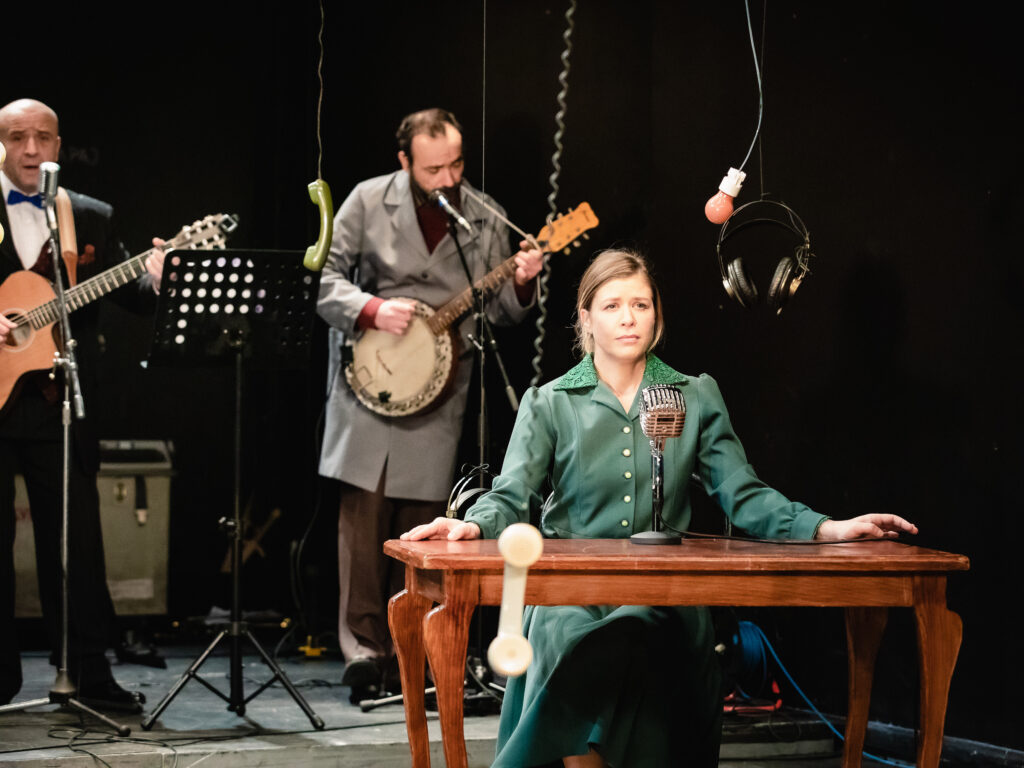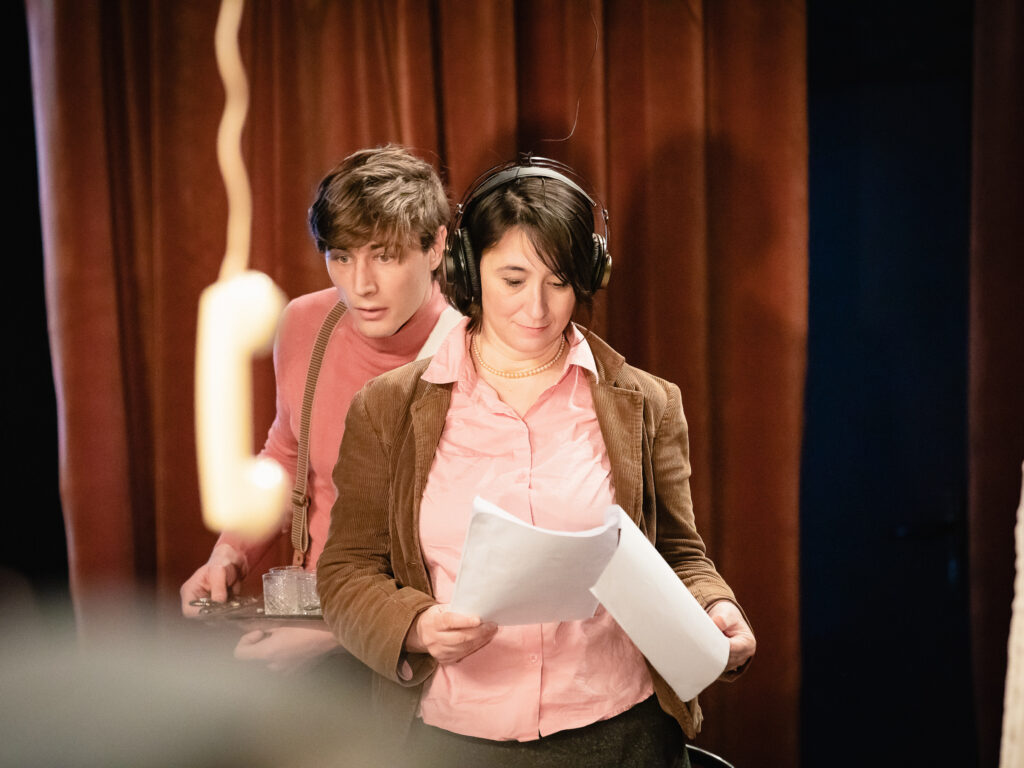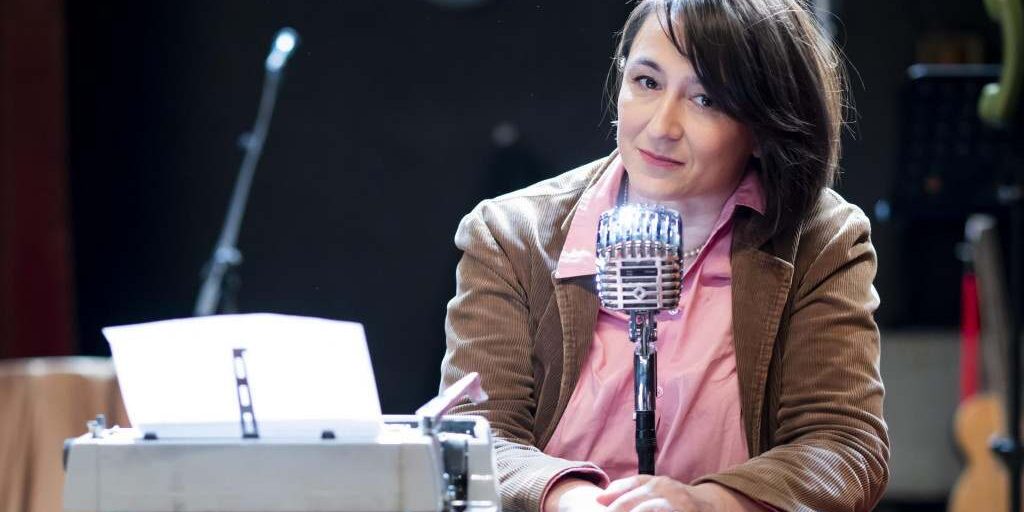Croatian theatremaker Pavlica Bajsić Brazzoduro talks to Lucija Klarik about the development of her particular model of radiophonic theatre and the power of sound.
Lucija Klarik: The first show you directed and created locally was Hoerspiel with the subtitle “a little play for listening (and watching)”. It seems like the second part of the title is very indicative of your approach to theater. Can you elaborate a bit on what it means to first listen and then to watch theater?
Pavlica Bajsić Brazzoduro: I suppose I am on a certain mission of promoting concentrated listening wherever I may find myself: on the radio (fictional or documentary), in movies, radio-walks, in certain types of sound-walks in which I use a broad spectrum of radio genres or audiobooks. The biggest leap of them all was to put radiophony on the theater stage and amongst living actors.
At first, I was embarrassed to reveal in the Hoerspiel programme that, in the first 15 minutes of the show, the audience exclusively listens to a radio performance and does not watch anything. I thought to myself that nobody would come to the performance, if they knew. Now, almost 10 years after the premiere of Hoerspiel and by having numerous encounters with our audiences, I can say that it all made sense.
At the time of our early performances, the actor Sven Medvešek would photograph the faces of the audience when they would see for the first time the “little people from the radiobox” who were hiding until that moment, creating the radio programme which they were listening to in the beginning of the show. When you see these faces in the audience caught in the photographs, these faces who are struck by wonder when they see the source of the sound they were listening to just moments ago, it’s the most beautiful document of our little miracle. Everything is based on these perception gymnastics, the leap that happens between when we only hear the sound and when we also see its source.
LK: The idea behind radiophonic theater may seem self-explanatory but it is actually a format that is not well-known or defined. How did this need to open the radiobox come to be and how did you decide for it to happen in the theater? Shortly, what is radiophonic theater?
PBB: It’s true, the basic idea is simple: we make shows that can be listened to on the radio or we put a radio show on the stage that has the potential to be watched. And by that I don’t only mean a mere audio transmission where we constantly lack what we are not seeing but that the audio itself creates a whole new dimension.
Why did radiophonic theater come to be? Simply because I, as a student of dramaturgy, started to work as part of creative teams in the theater or on films. On my radio work which was happening parallel to that my colleagues from the theater field were looking down at or with a dose of scepticism, even pity. At one moment I stopped trying to explain the creative possibilities and the freedom that the audio offered and this suppressed voice of mine which wanted to collide the two worlds so much, was put to sleep for 15 years. And we know what happens to things that are suppressed – one time or the other, they have to explode. I was wandering as a dramaturg through different author teams, pointlessly trying to find my place. My endeavors were only average. Only when I started to connect the things that were really my interests and decided to stand in front of people and take them somewhere, did things start to fall in place. A feeling of a new beginning was born in me.
The idea of radiophonic theater is actually in complete opposition with the concept of radio’s magic. That magic of the radio lies in a different place: listening to the sound we don’t know the source of, we have the freedom to create associations and images in our heads and because of that our listeners become our co-creators. When the image is missing and we are only left with the sound, that break allows for our brains to turn to the inner mechanisms of imagination and it evokes our conscious and unconscious thoughts, our emotions, memories, projections. It is not without reasons that the Germans use the expression “Kopfkino” for the radio art which can be freely translated to “cinema for thoughts”.
In all of my radiophonic performances I play with these two perceptions and this is our theater play. In fact, we are playing with the inner and the outer mise-en-scène. With the dynamics of perception that is produced when we listen to the wings of the bat and then we see the leather glove in Dino’s hands on the stage.

Halo, halo here is Radio Zagreb at ZKM. Photo: Marko Ercegovic
LK: What are the differences in the process and in your authorial thinking when you work for the radio and when you think of radiophonic theater? How does one fill in the other?
PBB: In theater rehearsals I often have to restrain my radiophonic imagination. The radio is more free in the sense of montage; at the core of the sound is duration, the process of listening takes time. Theater actors on the other hand, need movement, gesture, dynamics and a directing hand that will guide them through it. A microphone on stage is often restraining. It doesn’t matter that I’m not using the microphone for the volume but because I want to be able for the actors to perform with only their breath, if necessary. A microphone is, namely, to the voice like a film camera is to the face. It emphasizes. And by that it is forcing you to minimalism in your playing. If you don’t respect that, you lose the whole impression of the sound weaving and the finesses can not be heard.
For this reason, it’s easier to work with musicians. We will understand each other better on this subject of “acoustic direction”. For me, it is ideal to work in interdisciplinary teams, the way I worked at the beginning – with actors who are excellent radio actors and who love to do that, with musicians, sound engineers and radio authors on the stage. It’s also logical, this ensemble because these are “the little people from the radio box”.
As far as radio direction is concerned, last summer I made an audio book of poetry for children from the wonderful author Zvonimir Balog and the selection of his work from the Invisible Iva collection. Together with the ensemble of the Theater Poco Loco, Boris Miholjević, our children and the Belgrade based artist Kralj Čačka and his brother Marko Marić. Balog was given musical numbers on the verge of a cabaret sound, only the piano and the singular voice of my son Pavle just before his voice was to mutate. It is maybe the dearest radiophonic thing I have ever made and it can be found in the edition of Book&Zvook, the mobile application. I’m sorry we can’t popularize those sorts of things more; I believe it would be interesting for the grown-ups as well as for the children. But it seems that I have to still make a show out of everything for the audience to listen.
LK: Halo, halo here is Radio Zagreb, which recently premiered at ZKM is based on documentary materials and the biography of Croatian actor and writer Božena Begović. What was the motivation to make a show about Božena’s life and work?
PBB: “I had a lot of connections, but I was not able to beg.”, is something that Božena Begović noted in her autobiographical writing. Likewise, the material for this performance is composed of the attempts to represent the complexity of Božena’s life which is not obvious at the first glance. Božena is masterfully hidden behind the information of the first salute on the radio waves in these parts, a salute that has turned into her label. On the one hand, Božena’s a restless initiator, a pioneer in many regards, a constructor of a very interesting biography who in the recordings which are available to us didn’t talk a lot about herself, almost at all. On the other hand, she is a highly sensitive person torn between the strong aspiration to guard her own vertical, her complex relationship with her father, the inner struggle to create, to love a woman, to position herself as a female author at the time, to overcome the linguistic and cultural metamorphosis from German to Croatian – and survive all of that.
There are a lot of elements I could identify myself with although I was born 70 years later. But this part is less important because we don’t only do shows about the stuff we can identify with. What is important is that I can understand Božena and this I can mostly through her trying to create in numerous cultures and languages. As I have been working, studying and raising kids in Zagreb, Paris and Berlin, I know the heaviness of this burden but I also know the wings it gives you. Moreover, I can understand very well that because of existential worries you can’t afford the time or the energy to work creatively. More so because you are a woman which is something that usually closes certain channels that just need to be opened to let the streams flow, even if it means that you will make mistakes on the path to produce something creative. And the fact is that you need to earn through your work to survive, day by day. These prolongations if by chance last too long and fall on a fertile land can only bring about more insecurities.

Halo, halo here is Radio Zagreb at ZKM Photo: Marko Ercegovic
LK: Biopics are a popular genre in cinema but I would say that biographical theater shows are more of a rarity. What was your guiding principle when trying to depict Božena’s life?
PBB: We tried to keep the focus on her, Božena. This was a difficult task because her life path was offering a lot of layers and questions which were distracting from what was essential. This is the reason why we, just a few rehearsals before the premiere, decided to leave out a scene that was very dear to us and which the audience would certainly like but dramaturgically, it would hurt Božena.
The frame for this performance is actually an hour and 15 minutes of a late afternoon in a loft located at the Jurjevska street. The afternoon in which Božena will go, called by the radio station, to record the reconstruction of the first, well-known salute to the audience of Radio Zagreb and by this gesture seal the insignificance of everything else she created in her life. This act of recording happened only a few years before her death and it doesn’t actually date from 1926. Moreover, in 1926. it was not Božena who said the salute but rather the founder of the radistation, dr. Ivo Stern who later, as a Jew, migrated out of the country. During this fictional time in the Upper Town loft the strings of Božena’s life unravel and entangle, however you want to look at it.
I have to say that for a Hollywood movie the biography of her life companion, Joelle Joe Vuković, who lived with Božena Begović for three decades in the Jurjevska loft would be far more ideal. Joe was a chemistry graduate from the royal family Vuković who early in her life was left without her father, the official. In her time, she was living in France, waiting to be accepted to the La Légion étrangère. She would circumambulate the lavender fields close to Aix-en-Provence where the lab she was working for was located and parallel to that studying engineering in Paris. We used to joke around in the rehearsals that in a few years we will make a sequel called: Joelle’s truth.
They both were educated abroad – Joelle in French and Božena in German. The return to Zagreb that meant her literary and theatrical work should be made in Croatian has demanded a process of adjustment that lasted 10 whole years in Božena’s case. Between all the other troubles, this also affected the damaging of her career path. They were both also ardent antifascists and anti-Stalinists, no matter their family background and the current political affairs.
LK: Documentarism is a big part of your work on the radio and in the theater. What attracts you to the documentary material and how do you incorporate it in the performance where it collides with the fictional and the realities of the stage?
PBB: Above all, what I am interested in is the fiction that comes from the audio documents and the montaging possibilities that arise from them. Maybe the better question would be why pure fiction is not enough for me or is not important enough.
In theater we always encounter this problem of balancing the recorded audio material and the live play. Perhaps it is not really a problem but a matter of testing the limits. This is something that I wanted our long term cycles of little forms “A Plan to Escape” to serve. To stretch out the form and see where it can lead us, without the pressure of putting on a whole theater performance.
In my shows I have approached the combining of recorded materials and live play in different ways and have churned out various hybrids. In some I have even performed myself. From the warm and poetic Hoerspiel, the choreography-based, site-specific Orfej Listens to the Radio which was performed at the Dubrovnik’s fortress Bokar, Eter over Berlin which dived most deeply in the German radio archives to the a bit parody-like War of the Worlds that was a show for children and the impressionistic radiophonic diary which is the Soundtrack for the Movie That Was Never Filmed and in the end, to the very theatrically and documentary conventional Halo, Halo, Here is Radio Zagreb. The answers are numerous and diverse.
I’m happy that I was able to be on this 10-year journey and that it resulted in the creation of RadioTheater. I’m also pleased that I was researching this form with various artists and co-authors and not by only focusing on my own opus.
For more information on Halo, Halo, Here is Radio Zagreb, visit ZeKaEm.hr








